KV7006 Machine Learning Assignment
Introduction
Python is scripting language in the machine learning has used for predicting the analysis. Malaria is a disease that can be transmitted caused by the different parasites generally belonging to the categories of the plasmodium family. It is generally spread by the female mosquito which carries communicable diseases. The traditional way of detecting the malaria disease is by examining the blood cell under the microscope which shows the cell is infected with the parasites. This process required high assistance and a lab room along with the essential equipment and a highly experienced person for diagnosis. A modern method of detection of cells images for detecting malaria. In this report CNN has implemented with the malaria cell images. Image classification using deep learning models like convolutional neural network (CNN) is used for detecting the image cell presence of parasite with the non-infected cells images.
1. Understanding the dataset and its Characteristics
The dataset has been used for the detection of the cell which compares the presence of parasite cells which is infected with the non-infected cells. As per the view of Delgado-Ortet et al. (2020), the dataset mainly consists of 27558 images which generally belong to the two classes.

Figure 1: Import libraries and dependencies
(Source: self-created in juypter notebook)
The algorithm is used for the detection of parasite presence in malaria which can obtain maximum accuracy while detecting the image cell. The model is designed for the achieving the higher accuracy using the deep learning algorithm.
- The detection and segmentation of the blood cell which has level set algorithm.
- The images are mainly collected and interpreted by medical professionals.
2. Pre-Processing Data
Data preprocessing
The design has used the convolutional neural network which has the ability to extract feature and transfers learning. As per the view of Fuhad et al. (2020), the learning filter is an unsupervised learning method for the extraction of meaningful information from a set of images. Machine learning shows the solution for the programming feature like size, morphology of the cells, and color.

Figure 2: Creating list and array for detecting the image folder
(Source: self-created in juypter notebook)
The convolutional neural network increases the ability of faster prediction with obtaining maximum accuracy. Several things are used in machine learning suchas Keras, TensorFlow, NumPy, sci-kit-learn, Matplotlib, and imutils as package installers.
- The model has been built using the data preprocessing which initially imports libraries like pandas for the data manipulation analysis of the data for the detection of malaria parasites.
Numpy is used for the computing fundamentals.
Matplotlib shows the visual effect or plotting graph which generates or shows the affected part of malaria.
Scikit learn is used for the data preprocessing techniques.
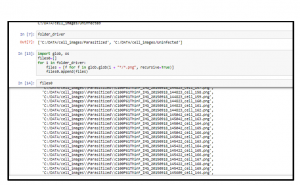
Figure 3: Print the list file
(Source: self-created in juypter notebook)
- Read data is an essential part where the model read the data which supports different file formats which shows the dataset
- In the data preprocessing it checks for the missing value which is generally found in the dataset having the null value.
- It checks the different categories of data where variables are set to the target variables.
- Standardized data is required to convert the format of the data which enables the users for the process and it uses to analyze it.
- The principle of component analysis which is used to decrease the size for the feature space where information is the maximum stored using less size.
3. Model
Algorithm 1: CNN Classification
Algorithm 2: Alexnet Classification
The model has been developed using the deep learning which is generally used for image classification and the analysis of images.
The images are shown in the below screen
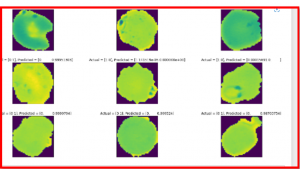
Figure 4: display image
(Source: self-created in juypter notebook)
The deep learning method increases the efficiency and performance. As per the view of Guo et al. (2021), the conventional neural network uses the deep learning method for the computer visualization which extracts feature that passes through the neural network for the classification of the image for increasing the accuracy.
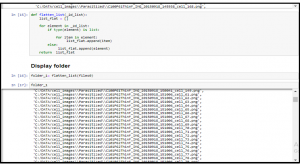
Figure 5: Display folder
(Source: self-created in juypter notebook)
The CNN is used for the classification of the data which chooses the fit function for the training the model and testing the model. For training, the model approximately twenty thousand images have been used for the dataset.

Figure 6: Data frame creation
(Source: self-created in juypter notebook)
After training the model the next method is validation. In this, the testing of the image classification process is executed for checking whether the data is showing a high accuracy level or less accuracy level. It generally checks the how the prediction class result obtains the higher result.
- The algorithm that is used for the detection of malaria as an input image which is to remove noise from the image cell of red blood cells.
- The preprocessing of the image which cleans the cell image dataset.
- The image segmentation is the next phase where the image segmentation extracts the required segment of the image.
- The next phase is the classification which uses an input feature of vectors and produces the output which is classified as parasite malaria infection and non-infected image infection.
![]()
Figure 7: CNN classification
(Source: self-created in juypter notebook)
The model is developed for the detection of malaria which classifies the image into two categories parasite and uninfected. Then the data preprocessing is done analyze the dataset for a better prediction. Then transfer learning is used to make a connection like a neural network that can transmit and relate with the other image cell and find meaningful information from the image cell for the detection. As per the view of Masud et al. (2020), image segmentation basically extracts only the needed part of the image for the classification of the image.
4. Evaluation of Model Predictions
The model predicts the performance on the basis of image segmentation. As per the view of Pattanaik et al. (2020), the confusion matrices show the traditional and the modern way to achieve the accuracy level on the bases of testing which generate image segmentation automatically and manually in the traditional way.
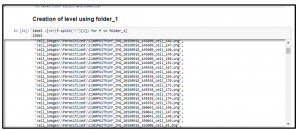
Figure 8: level creation
(Source: self-created in juypter notebook)
The better case which can generally has obtained a higher result of prediction accuracy on the bases of the test on the data set.
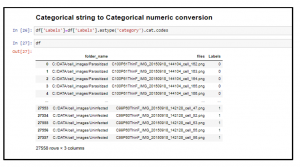
Figure 9: Numerical conversion from string
(Source: self-created in juypter notebook)
The result which is obtained from the manual segmentation that evaluation is set to strong argument for the generalizing the training model. The new collection is not trained but it is able to perform by acquiring the accuracy in an effective manner.
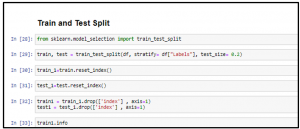
Figure 10: Training and testing splitting
(Source: self-created in juypter notebook)
Malaria disease is identified using the processing technique of images using the deep learning algorithm. It is essential for the development to generate the detection of the disease. The model aims for an automated system to detect the malaria parasite in the blood smear which uses the convolutional neural network.
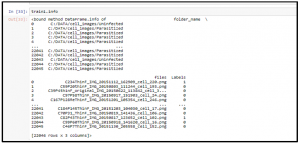
Figure 11: Data model training
(Source: self-created in juypter notebook)
The performance is based on the occurring level of accuracy. As per the view of Yang et al. (2019), the extracts of the feature and process of training are obtaining accuracy. The model built which composed of different layers using the resnet or residual network.
5. Best Model
The Fine tune model
The approach that has been chosen for the classification and detection of malaria disease uses the convolutional neural network which shows the performance of the infected and uninfected parasite cells.
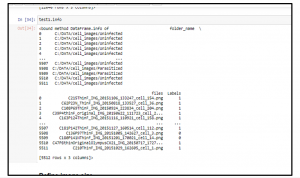
Figure 12: Testing data model
(Source: self-created in juypter notebook)
The result of the model is based on the testing plan. In the first the test was conducted then the performance had a low accuracy level of 96 percent and a loss of 1 percent.
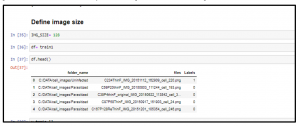
Figure 13: Resizing the image size
(Source: self-created in juypter notebook)
Then a repeated test was conducted to improve the convolutional neural connection and the transfer learning method which trains the data model for improving the data model. When the second test it shows the result obtained is 98 percent. The network layer has to learn the mapping which is allowed by the residual mapping for the best fit.
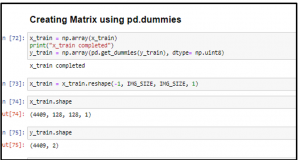
Figure 14: Creating the matrix
(Source: self-created in juypter notebook)
Algorithm two that has been used for the classification.
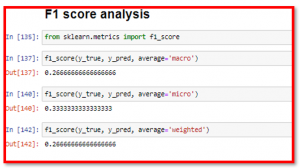
Figure 15: F1 score analysis for the first model
(Source: self-created in juypter notebook)
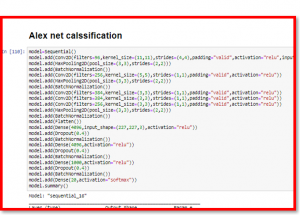
Figure 16: Alex Net classification
(Source: self-created in juypter notebook)
6. Findings with Visualization
The result is based on the training of neural networks that focuses on less time for training the model. The model is faster for obtaining the model accuracy for the predictive result which has certainly parameter and memory requirements.
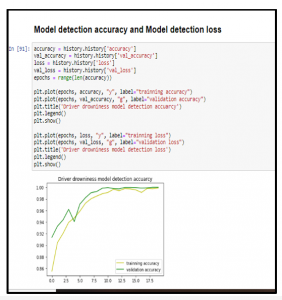
Figure 17: Tune graph of the model
(Source: self-created in juypter notebook)
The detection of the malaria disease shows the model for generating performance which is to increase the level of performance and accuracy level to 99 percent which indicated that the model performance is reaching a higher level of accuracy.

Figure 18: Epoch result
(Source: self-created in juypter notebook)
It can reduce the risk for identification of malaria-infected people which can harm other and treat themselves at the earliest.
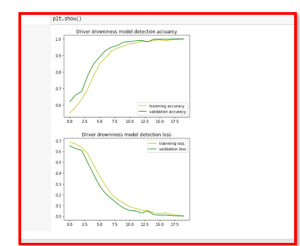
Figure 19: accuracy and loss curve
(Source: self-created in juypter notebook)
It show the result of the model accuracy and loss curve in the above figure
7. Critical Evaluation
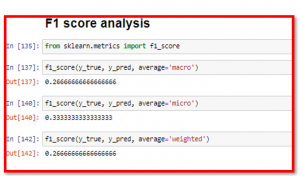
Figure 20: F1 score analysis
(Source: self-created in juypter notebook)
In the given figure it show the F1 score analysis of the measurement considering the precision and recall for the score to be computed. It shows the average weights of precision and recall values while it reaches to get the best result 1 and worst values to be 0. It is required to show lower result for greater efficiency.
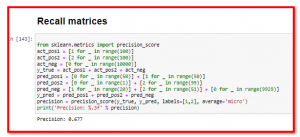
Figure 21: recall matrices
(Source: self-created in juypter notebook)
The metrics is lower in the impulsive segmentation evaluation which focuses on the attribute with the deficiencies with the simple approach of segmentation. As per the view of Shekar et al. (2020), the cell segmentation does not have any scope of work for the manual segmentation that set an indicative to increase the performance of the model capacity.
Conclusion
The report has concluded that the design prototype and the testing prototype for the better prediction which can show gain accuracy, and loss of the model for the detection of the malaria disease. The CNN is based on the deep learning which focuses on the small details of the blood cell for the detection. In this detection of malaria is more effective and fast with detection in less time with obtaining higher accuracy of the result. This system can be more effective in the detection which required less resources and effort in detection. It also does not required an expert for the process detection. This cell detection effect with parasites can help in different ways where largely required to know the true cause and different variety of malaria for the detection which can prevent from spreading from one person to another.
There are two algorithm has been used one is CNN or convolutional neural network and another is Alex Net which has been used for the classification and detection of the image cell of the malaria disease. CNN uses an efficient method of recognition which recognition and process the images. It has various feature like structure, less time for training and adaptive nature. The Alex net consist of different layer which has a large impact on the machine learning and deep learning. It allows multiple GPU training which separate the model neuron in the half GPU and other half on the different GPU. It also decrease the time consumption.
Reference list
Delgado-Ortet, M., Molina, A., Alférez, S., Rodellar, J. and Merino, A., 2020. A deep learning approach for segmentation of red blood cell images and malaria detection. Entropy, 22(6), p.657.
Fuhad, K.M., Tuba, J.F., Sarker, M., Ali, R., Momen, S., Mohammed, N. and Rahman, T., 2020. Deep learning based automatic malaria parasite detection from blood smear and its smartphone based application. Diagnostics, 10(5), p.329.
Guo, X., Khalid, M.A., Domingos, I., Michala, A.L., Adriko, M., Rowel, C., Ajambo, D., Garrett, A., Kar, S., Yan, X. and Reboud, J., 2021. Smartphone-based DNA diagnostics for malaria detection using deep learning for local decision support and blockchain technology for security. Nature Electronics, 4(8), pp.615-624.
Masud, M., Alhumyani, H., Alshamrani, S.S., Cheikhrouhou, O., Ibrahim, S., Muhammad, G., Hossain, M.S. and Shorfuzzaman, M., 2020. Leveraging deep learning techniques for malaria parasite detection using mobile application. Wireless Communications and Mobile Computing, 2020.
Pattanaik, P.A., Mittal, M. and Khan, M.Z., 2020. Unsupervised deep learning cad scheme for the detection of malaria in blood smear microscopic images. IEEE Access, 8, pp.94936-94946.
Shekar, G., Revathy, S. and Goud, E.K., 2020, June. Malaria detection using deep learning. In 2020 4th International Conference on Trends in Electronics and Informatics (ICOEI)(48184) (pp. 746-750). IEEE.
Yang, F., Poostchi, M., Yu, H., Zhou, Z., Silamut, K., Yu, J., Maude, R.J., Jaeger, S. and Antani, S., 2019. Deep learning for smartphone-based malaria parasite detection in thick blood smears. IEEE journal of biomedical and health informatics, 24(5), pp.1427-1438.
Know more about UniqueSubmission’s other writing services:

